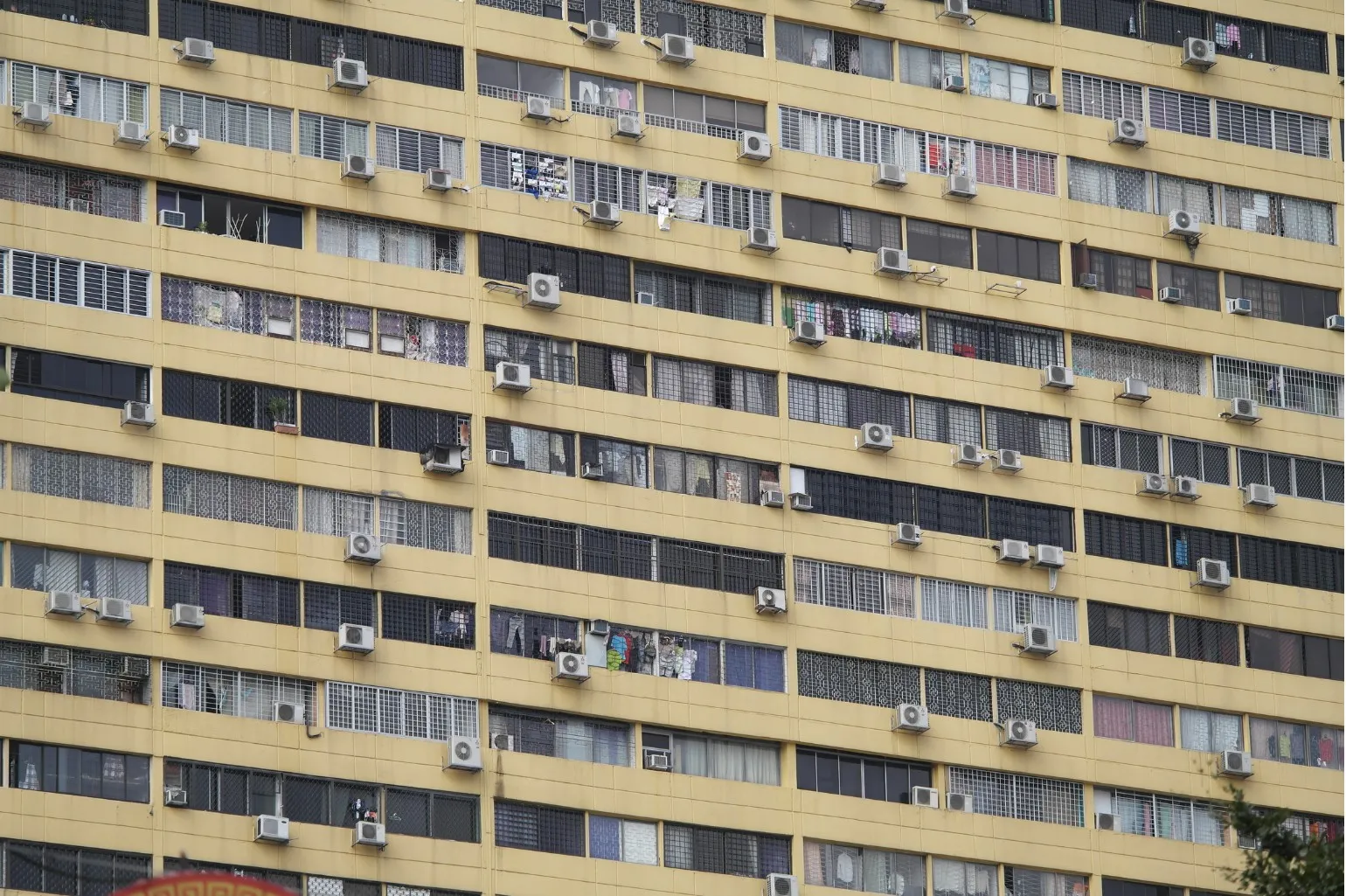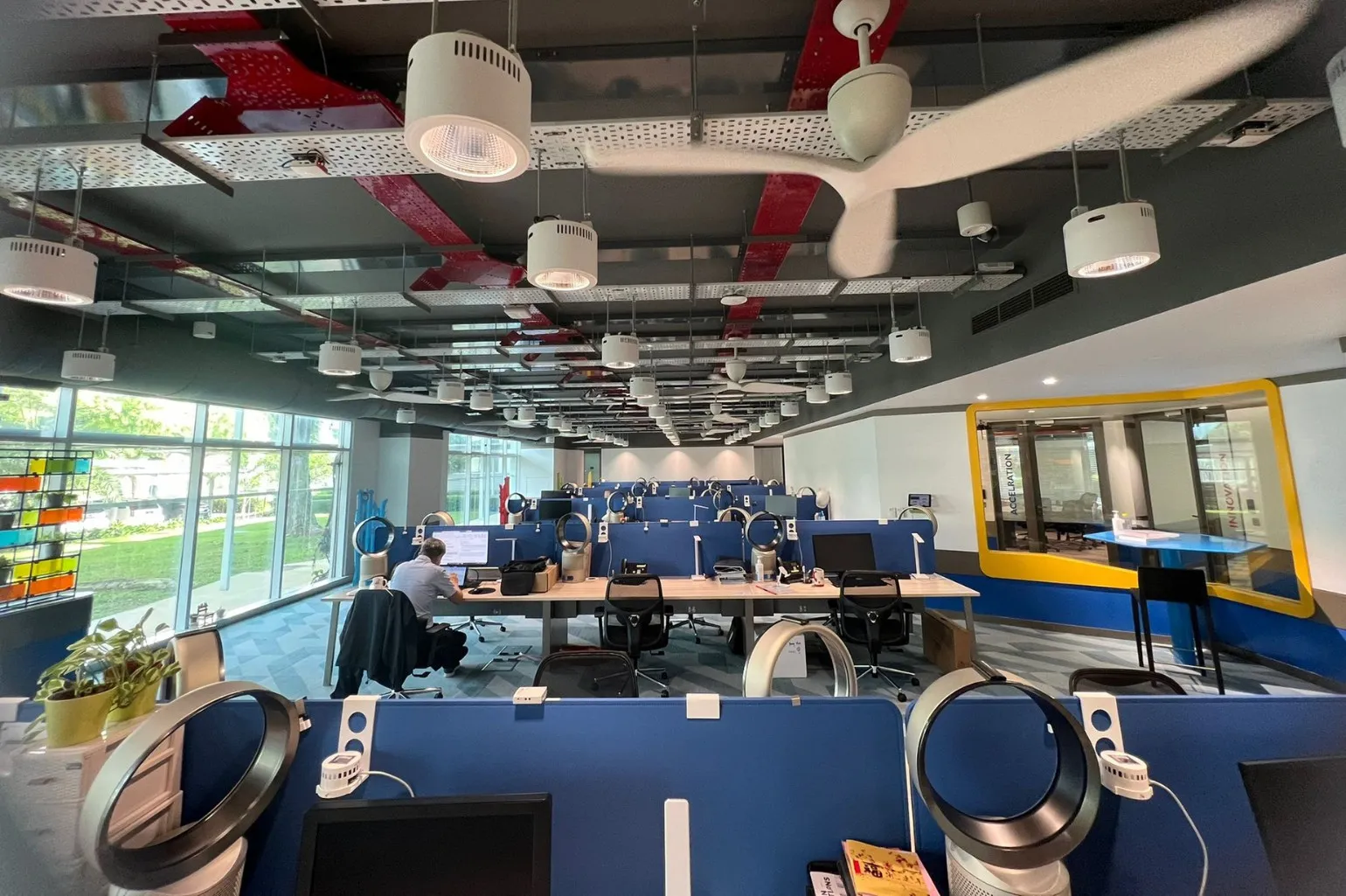Hybrid Cooling Leads to Significant Energy Savings in Tropical Office Buildings

An alliance between UC Berkeley researchers and academic and industry partners in Singapore has demonstrated that combining ceiling fans with higher air conditioning set points can lower energy use by one-third — without sacrificing occupant comfort.
In Singapore, an island city-state just one degree north of the equator in Southeast Asia, where the weather is hot and humid year-round, air conditioning (AC) has been called the “unspoken energy guzzler.” According to sustainable development and policy specialist Kavickumar Muruganathan, household and building AC usage accounts for nearly 20 percent of the country’s carbon emissions.
Given Singapore’s status as one of the most urbanized and densely populated countries in the world, a considerable number of those air conditioning systems are located in commercial properties, such as office buildings.
Investigators at the Berkeley Education Alliance for Research in Singapore (BEARS), a research-focused nonprofit company established in Singapore by the University of California, Berkeley, have worked with industry partners in Singapore to successfully pilot a cooling solution for office buildings in tropical climates that offers an impressive energy savings of more than 30 percent without reducing occupant comfort. Their technique pairs air conditioners, set to a temperature slightly higher than standard, and ceiling fans, which require much less energy to operate, in a method known as hybrid cooling.

Their experiment, as described in a study published in the September issue of Building and Environment, was led by research fellow Michael Kent, with senior authors Stefano Schiavon, an investigator at the Center for Information Technology Research in the Interest of Society and the Banatao Institute (CITRIS) and the UC Berkeley Center for the Built Environment and professor of architecture and civil and environmental engineering at UC Berkeley, and Costas Spanos, director of CITRIS, Andrew S. Grove Professor of Electrical Engineering and Computer Sciences at UC Berkeley, and CEO of BEARS.
The researchers are affiliated with Singapore-Berkeley Building Efficiency and Sustainability in the Tropics (SinBerBEST), a program within BEARS that focuses on optimizing energy efficiency in the built environment. Founded in 2011, SinBerBEST is funded by Singapore’s National Research Foundation.
The team developed the concept in SinBerBEST’s cyberphysical test bed on the Campus for Research Excellence and Technological Enterprise at the National University of Singapore. Testing took place in a “living laboratory” in the Zero Energy Plus Building at the Building and Construction Authority Academy in Singapore, where a retrofit completed in 2020 (PDF) incorporated robust real-time indoor environmental quality monitoring and control.
Straightforward premise, significant results
Over the course of 11 weeks, the researchers polled office occupants twice daily on their thermal comfort while alternating between two cooling conditions in the open-plan space: In the first, the AC was set to 24 C (75.2 F) — close to the average Singaporean office temp — with all fans turned off, while in the second, the AC was raised to 26.5 C (79.7 F), with the ceiling fans turned on to provide fixed airflow. Individual desk fans were also available at each station for office occupants to use at will.
Study participants were asked to rate their comfort levels regarding the ambient building temperature, including any perceived air staleness, their feelings of alertness or sleepiness, and their ability to concentrate.

While the premise may seem simple, the results were significant.
“We achieved a remarkable 32 percent reduction in energy consumption without compromising thermal comfort,” Schiavon said. “By simply adjusting the thermostat temperature set point from 24 C to 26.5 C and incorporating fans, we achieved a one-third reduction in energy use — exceeding my expectations.”
Not only was thermal comfort retained with the hybrid cooling method, conditions in fact improved for some occupants. Overcooling, due to air conditioning set too low, is a common issue in Singapore and other hot, humid settings, and the SinBerBEST study saw reports of perceived overcooling drop from 33 percent to 9 percent when the AC setpoint was raised.
“By simply adjusting the thermostat temperature set point and incorporating fans, we achieved a one-third reduction in energy use — exceeding my expectations.”
STEFANO SCHIAVON, PROFESSOR AT UC BERKELEY
Previous research by Schiavon has shown that overcooling has a disparate impact on office workers by gender, with women more heavily affected by chilly temperatures.
The study’s authors also observed that occupants of the Zero Energy Plus Building were already relatively comfortable with the existing conditions, with only 7 percent indicating thermal dissatisfaction with the AC set at 24 C. Hybrid cooling may yield even more significant benefits in buildings with a lower baseline satisfaction level than the high-performance ZEB+.
Reintroducing proven tech in retrofits
While constructing new energy-efficient buildings is relatively straightforward with modern technology and techniques, much of the built environment is indeed already built. However, retrofitting existing structures with new tech can offer unexpected challenges. That’s why the SinBerBEST team members have focused their attention on an established technology — the humble electric fan — as it can be incorporated into any building, regardless of age.
Spanos noted that the researchers initially saw a measure of cultural resistance to the idea of reintroducing older tech like fans into modern buildings. While this presented issues, he said, a recent spike in electricity prices has helped to overcome some of these objections.
“Singapore has a very vibrant green building sector, which could make good use of the outcomes of this research.”
CHUAN SENG LEE, FOUNDING PRESIDENT OF THE SINGAPORE GREEN BUILDING COUNCIL
Schiavon notes that one of the primary obstacles in scaling their solution is a lack of comprehensive design and operation procedures. His team at the Center for the Built Environment and colleagues from SinBerBEST have created a guidebook for architects and building engineers to use for designing cooling systems with fans, including options for ceiling, wall, desk and pedestal models.
“With a proper design guide, we should be able to get more adoption by the industry,” said Chuan Seng Lee, founding president of the Singapore Green Building Council, member of the SinBerBEST Scientific Advisory Committee and an international environmental conservation advocate.
“Singapore has a very vibrant and active green building sector through its national Green Mark program, which could make good use of the outcomes of this research.”
Spanos described a multipronged approach to encouraging wider usage of hybrid cooling techniques in Singapore.
“In addition to broad demonstrations,” he said, “we are also developing communication strategies and partnerships with established consultancies so that we can achieve broader adoption.”
The work is already seeing some use. More than 10 academic and commercial buildings in Singapore have received light retrofit demonstrations with the team’s field evaluation kit, reporting energy savings of 27 percent and a 10 percent increase in occupant satisfaction.
“We are very hopeful that this can really make a difference in our fight to mitigate the effects of climate change.”
COSTAS SPANOS, DIRECTOR OF CITRIS AND THE BANATAO INSTITUTE
The SinBerBEST team also seeks to expand their research to residential buildings, as Schiavon notes that a key factor to achieving quality sleep is thermal comfort.
Spanos looks forward to seeing where the project evolves next, perhaps by developing ways to simulate the benefits of this kind of retrofit before a physical deployment, or by assessing how it could be used in climates beyond the tropics.
“We spend most of our time indoors, and, not surprisingly, residential and commercial buildings are responsible for about 40 percent of greenhouse gas emissions, worldwide,” Spanos said. “It is hard to come across solutions to reduce these emissions without sacrificing comfort, but this approach holds tremendous promise, especially for tropical climates.
“We are very hopeful that through a combination of minor and major retrofits, combined with new building codes for new construction, this can really make a difference in our fight to mitigate the effects of climate change.”
